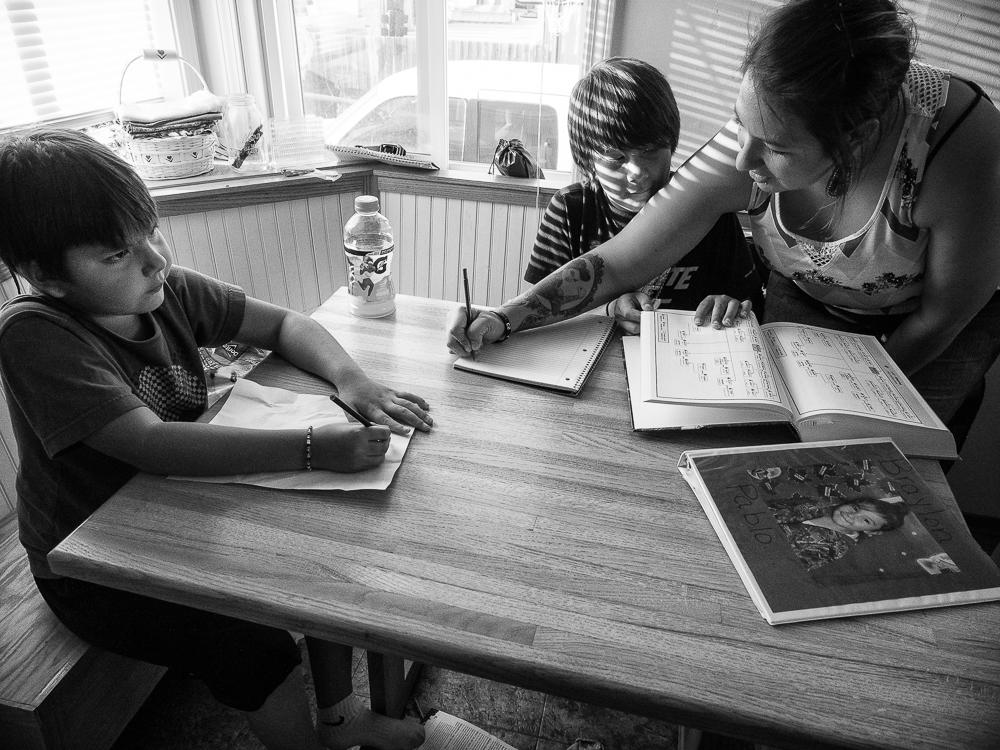Reclaiming Language

Nicole Pablo Helping Her Sons with Homework, Flathead Reservation, Montana, 2016 by Sue Reynolds
The photograph above shows Nicole helping her sons Talon and his older brother Landon with their homework. They are studying Salish, their Native language, which has its own alphabet. The large book is a Salish textbook. Talon and Landon are part of the first generation in a long while that will grow up learning their Native language, which helps them understand and be a part of their cultural heritage. Once when Landon went to the county fair, he was called a “cute girl” by non-Natives because, at that time, he wore his hair long. For Native boys and men, wearing their hair long in traditional style often causes problems. If they wear it long, they face non-Native prejudice and if they cut it, they may be told “You’re not Indian enough,” by other Natives.

The photo above shows Luke using an app to learn the Crow language. Luke’s father is Crow and his mother is Blackfeet but they live on the Flathead Reservation in western Montana where few people speak or teach Crow. It is particularly important to Luke’s father that he learn his Native language and he says Luke will understand the importance of this as he grows older. Like many Native languages worldwide, Crow is endangered. On the Crow Reservation in southeast Montana, the people work hard to renew their language through a partial immersion school, a Crow language dictionary and a language camp for teens.
Across the United States, many American Indian languages have disappeared. Of the estimated 154 Native languages that remain, half are spoken by only a few elders and are not being taught to children. On the Flathead Reservation, there are fewer than 50 fluent Salish speakers.
Discussion and Writing Questions
|
This excerpt from Victor Charlo's Poet's Statement details how, and why - as a boy - Victor's family thought it best that he learn English, not his native Salish language.
"Like many other Native American parents of the time, mine didn't teach us Salish, thought it best that I attend White Man’s schools and learn English so I would fit in and not struggle with being different. So I never learned Salish growing up. As a result, my work takes on a sense of loss about the sadness of tribal ways going away. My work reflects on Tradition and the necessity to honor and continue the Old Ways."
The poem below by poet Victor Charlo describes his attempts to speak Salish, the native language of his ancestors.
Click here to view poem full screen
The July, 1994
My Salish synapses firing the old Salish sounds as I try to
Talk perfect English to the Dame of Arlee Pow-Wow
I’m not doing good so I talk faster and faster
Trying to get a solid accent of some kind down
Not doing so good. My grandfathers spoke wonderful word
In fire, in sky, in wind, in rain,
In the heart of the chase.
Dirty Corner Poems and Other Stories, by Victor A. Charlo. Available on Amazon.
Discussion and Writing Questions
|
Click this link to explore how American Indians are celebrating their religious and cultural ceremonies: Reclaiming Ceremonies
Other ResourcesRising Voices/Hothanipi, by The Language Conservancy. YouTube. "Our Schools: Cuts Wood School." The Piegan Institute. |
Click here to access our extensive library of related websites, readings, videos, and more.
